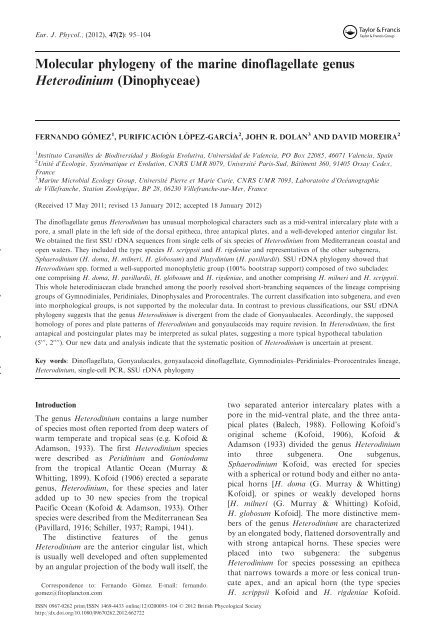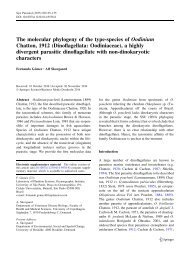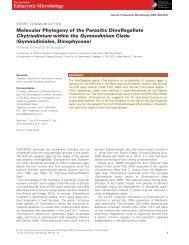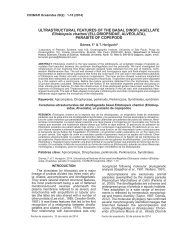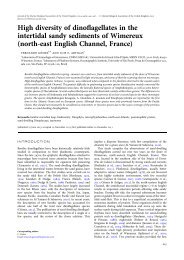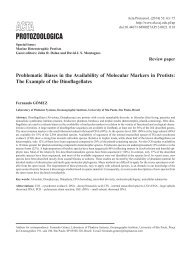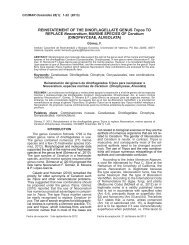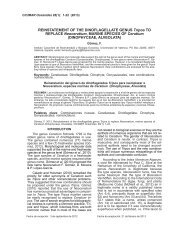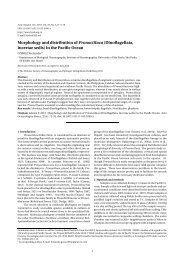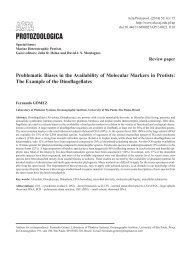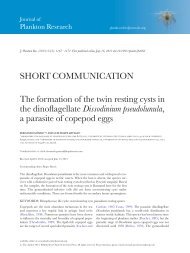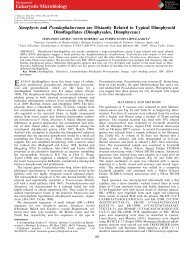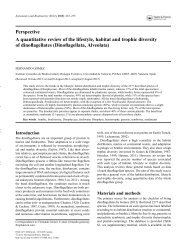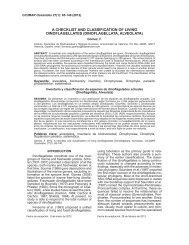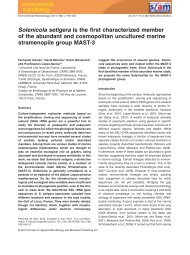You also want an ePaper? Increase the reach of your titles
YUMPU automatically turns print PDFs into web optimized ePapers that Google loves.
Eur. J. Phycol., (2012), 47(2): 95–104<br />
Molecular phylogeny of the marine dinoflagellate genus<br />
Heterodinium (Dinophyceae)<br />
FERNANDO GO´ MEZ 1 , PURIFICACIO´ NLO´ PEZ-GARCI´A 2 , JOHN R. DOLAN 3 AND DAVID MOREIRA 2<br />
1 Instituto Cavanilles de Biodiversidad y Biologıá Evolutiva, Universidad de Valencia, PO Box 22085, 46071 Valencia, Spain<br />
2 Unite´ d’Ecologie, Syste´matique et Evolution, CNRS UMR 8079, Universite´ Paris-Sud, Baˆtiment 360, 91405 Orsay Cedex,<br />
France<br />
3 Marine Microbial Ecology Group, Universite´ Pierre et Marie Curie, CNRS UMR 7093, Laboratoire d’Oce´anographie<br />
de Villefranche, Station Zoologique, BP 28, 06230 Villefranche-sur-Mer, France<br />
(Received 17 May 2011; revised 13 January 2012; accepted 18 January 2012)<br />
The dinoflagellate genus Heterodinium has unusual morphological characters such as a mid-ventral intercalary plate with a<br />
pore, a small plate in the left side of the dorsal epitheca, three antapical plates, and a well-developed anterior cingular list.<br />
We obtained the first SSU rDNA sequences from single cells of six species of Heterodinium from Mediterranean coastal and<br />
open waters. They included the type species H. scrippsii and H. rigdeniae and representatives of the other subgenera,<br />
Sphaerodinium (H. doma, H. milneri, H. globosum) and Platydinium (H. pavillardii). SSU rDNA phylogeny showed that<br />
Heterodinium spp. formed a well-supported monophyletic group (100% bootstrap support) composed of two subclades:<br />
one comprising H. doma, H. pavillardii, H. globosum and H. rigdeniae, and another comprising H. milneri and H. scrippsii.<br />
This whole heterodiniacean clade branched among the poorly resolved short-branching sequences of the lineage comprising<br />
groups of Gymnodiniales, Peridiniales, Dinophysales and Prorocentrales. The current classification into subgenera, and even<br />
into morphological groups, is not supported by the molecular data. In contrast to previous classifications, our SSU rDNA<br />
phylogeny suggests that the genus Heterodinium is divergent from the clade of Gonyaulacales. Accordingly, the supposed<br />
homology of pores and plate patterns of Heterodinium and gonyaulacoids may require revision. In Heterodinium, the first<br />
antapical and postcingular plates may be interpreted as sulcal plates, suggesting a more typical hypothecal tabulation<br />
(5 000 ,2 0000 ). Our new data and analysis indicate that the systematic position of Heterodinium is uncertain at present.<br />
Key words: Dinoflagellata, Gonyaulacales, gonyaulacoid dinoflagellate, Gymnodiniales–Peridiniales–Prorocentrales lineage,<br />
Heterodinium, single-cell PCR, SSU rDNA phylogeny<br />
Introduction<br />
The genus Heterodinium contains a large number<br />
of species most often reported from deep waters of<br />
warm temperate and tropical seas (e.g. Kofoid &<br />
Adamson, 1933). The first Heterodinium species<br />
were described as Peridinium and Goniodoma<br />
from the tropical Atlantic Ocean (Murray &<br />
Whitting, 1899). Kofoid (1906) erected a separate<br />
genus, Heterodinium, for these species and later<br />
added up to 30 new species from the tropical<br />
Pacific Ocean (Kofoid & Adamson, 1933). Other<br />
species were described from the Mediterranean Sea<br />
(Pavillard, 1916; Schiller, 1937; Rampi, 1941).<br />
The distinctive features of the genus<br />
Heterodinium are the anterior cingular list, which<br />
is usually well developed and often supplemented<br />
by an angular projection of the body wall itself, the<br />
Correspondence to: Fernando Go´ mez. E-mail: fernando.<br />
gomez@fitoplancton.com<br />
two separated anterior intercalary plates with a<br />
pore in the mid-ventral plate, and the three antapical<br />
plates (Balech, 1988). Following Kofoid’s<br />
original scheme (Kofoid, 1906), Kofoid &<br />
Adamson (1933) divided the genus Heterodinium<br />
into three subgenera. One subgenus,<br />
Sphaerodinium Kofoid, was erected for species<br />
with a spherical or rotund body and either no antapical<br />
horns [H. doma (G. Murray & Whitting)<br />
Kofoid], or spines or weakly developed horns<br />
[H. milneri (G. Murray & Whitting) Kofoid,<br />
H. globosum Kofoid]. The more distinctive members<br />
of the genus Heterodinium are characterized<br />
by an elongated body, flattened dorsoventrally and<br />
with strong antapical horns. These species were<br />
placed into two subgenera: the subgenus<br />
Heterodinium for species possessing an epitheca<br />
that narrows towards a more or less conical truncate<br />
apex, and an apical horn (the type species<br />
H. scrippsii Kofoid and H. rigdeniae Kofoid.<br />
ISSN 0967-0262 print/ISSN 1469-4433 online/12/0200095–104 ß 2012 British Phycological Society<br />
http://dx.doi.org/10.1080/09670262.2012.662722
F. Go´mez et al. 96<br />
The latter is often misspelled as ‘rigdenae’ but<br />
should be corrected according to ICBN Article<br />
60.11, Recommendation 60C.1, and Article 32.7:<br />
see McNeill et al., 2006), and Platydinium Kofoid<br />
for species with a strongly flattened epitheca<br />
that expands scoop-like with a rounded apex<br />
(H. pavillardii Kofoid & A.M. Adamson). While<br />
these groups appeared ‘natural’, uniting forms<br />
with shared morphological characteristics, it was<br />
admitted that the characters employed represented<br />
gradients among species in the two subgenera and<br />
thus the subdivision was perhaps mainly one of<br />
convenience (Kofoid & Adamson, 1933, p. 26).<br />
Kofoid gave the plate formula 3 0 , 1a, 6 00 , 6–7?c,<br />
7 000 , 3 0000 for the genus Heterodinium (Kofoid &<br />
Adamson, 1933). However, Balech (1962, p. 150)<br />
found only six cingular plates, and he interpreted<br />
the seventh postcingular one as a sulcal plate. He<br />
also identified two intercalary plates, a mid-ventral<br />
plate with a pore, and a small plate in the left side<br />
of the dorsal epitheca. Later, Balech (1988, p. 153)<br />
proposed the plate formula 3 0 , 2a, 6 00 , 6c, 6 000 ,3 0000 .<br />
The plates of the apex (apical pore complex, APC)<br />
of Heterodinium have a pore and a canal plate, as is<br />
usual in gonyaulacoids, and lack the plate ‘X’<br />
that is typical of peridinioids (see Table 1 in<br />
Steidinger & Tangen, 1997).<br />
Historically, the genus Heterodinium has been<br />
allied to various groups (Lindemann, 1928; Kofoid<br />
& Adamson, 1933; Schiller, 1937). In modern classifications,<br />
the family Heterodiniaceae is placed<br />
alongside the gonyaulacoid Ceratocoryaceae,<br />
Goniodomataceae and Ceratiaceae (Taylor, 1976;<br />
Sournia, 1986; Balech, 1988). The Heterodiniaceae<br />
are placed within Gonyaulacales when this order is<br />
separated from Peridiniales (Taylor, 1987;<br />
Steidinger & Tangen, 1997). Fensome et al. (1993,<br />
p. 114) listed the morphological characters that justified<br />
the placement of Heterodinium within the<br />
order Gonyaulacales, and they interpreted the distinctive<br />
morphological features of Heterodinium to<br />
be homologues of those in the typical<br />
Gonyaulacales.<br />
The assumed close relatives of Heterodinium –<br />
members of Ceratocoryaceae, Goniodomataceae<br />
and Ceratiaceae – are well nested in the monophyletic<br />
gonyaulacoid lineage in phylogenies based on<br />
small subunit (SSU) and large subunit (LSU) ribosomal<br />
DNA (rDNA) (see for example, Saldarriaga<br />
et al., 2004; Logares et al., 2007; Moestrup &<br />
Daugbjerg, 2007). Therefore, one would also<br />
expect Heterodinium to be well-nested within the<br />
gonyaulacoids. In this study we examine the systematic<br />
position of Heterodinium based on a<br />
molecular phylogeny and an analysis of morphological<br />
features. In particular, we provide 12 new<br />
SSU rDNA sequences of six species of the genus<br />
Heterodinium; among these are representatives of<br />
all three subgenera and the type species,<br />
H. scrippsii.<br />
Materials and methods<br />
Sampling and isolation of material<br />
Specimens were isolated from water samples collected at<br />
three coastal sites in the north-western Mediterranean<br />
Sea (Marseille, Banyuls-sur-Mer, Villefranche-sur-Mer)<br />
and two open-water sites in the eastern Mediterranean<br />
Sea. At the Marseille site, surface water was sampled<br />
from the pier (water depth 3 m) of the Station Marine<br />
d’Endoume, Marseille (43 16 0 48 00 N, 5 20 0 57 00 E) from<br />
October 2007 to September 2008. Ten to 100 litres of<br />
seawater, according to the concentration of particles,<br />
were slowly filtered using a plankton concentrator<br />
fitted with Nitex screening (20, 40 or 60 mm mesh-size).<br />
In addition, we also studied samples collected during<br />
several monitoring research cruises to the SOMLIT<br />
(Service d’Observation en Milieu LITtoral) station in<br />
the Bay of Marseille (43 14 0 30 00 N, 05 17 0 30 00 E, bottom<br />
depth 60 m). Seawater samples were collected with a<br />
12-litre Niskin bottle at 40 and 55 m depth and filtered<br />
as described above. The concentrated sample was examined<br />
in Utermo¨ hl chambers at 100 magnification with<br />
a Nikon inverted microscope (Nikon Eclipse TE200)<br />
and was photographed at 200 or 400 magnification<br />
with a digital camera (Nikon Coolpix E995). Sampling<br />
continued from October 2008 to August 2009 in the surface<br />
waters of the port (depth of 2 m) of<br />
Banyuls-sur-Mer, France (42 28 0 50 00 N, 3 08 0 09 00 E), and<br />
from September 2009 to February 2010 in the Bay of<br />
Villefranche-sur-Mer, Ligurian Sea. For the latter location,<br />
sampling was performed at the long-term monitoring<br />
site Point B (43 41 0 10 00 N, 7 19 0 00 00 E, water column<br />
depth 80 m). This site, located on the slope of a submarine<br />
canyon, is well known to be rich in deep-water<br />
plankton organisms associated with the upwelling of<br />
deep water (Bougis, 1968). Water column samples<br />
(0–80 m) were obtained using a phytoplankton net<br />
(53 mm mesh size, 54 cm diameter, 280 cm length).<br />
Samples were prepared according to the same procedure<br />
as described above and specimens were observed with an<br />
Olympus inverted microscope (Olympus IX51) and photographed<br />
with an Olympus DP71 digital camera.<br />
Open-water samples were collected during the BOUM<br />
(Biogeochemistry from the Oligotrophic to the<br />
Ultra-oligotrophic Mediterranean) cruise in the<br />
Mediterranean Sea between the Gulf of Lions and<br />
Cyprus in June–July 2008. Ten litres of seawater were<br />
collected from the surface with a bucket and filtered by<br />
using a strainer of 20 mm netting aperture. The material<br />
retained was fixed with absolute ethanol to a final concentration<br />
of 50% concentrated sample and 50% ethanol.<br />
In the laboratory, the ethanol sample was examined<br />
following the procedure described above.<br />
After being photographed, each Heterodinium specimen<br />
was micropipetted individually with a fine capillary<br />
into a clean chamber and washed several times in a series<br />
of drops of 0.2 mm-filtered and sterilized seawater (live<br />
specimens from coastal waters) or ethanol (ethanol prefixed<br />
specimens from open waters). Finally, the
Molecular phylogeny of Heterodinium 97<br />
specimen was placed in a 0.2 ml Eppendorf tube filled<br />
with several drops of absolute ethanol. The sample was<br />
kept at room temperature and in darkness until the<br />
molecular analysis could be performed.<br />
PCR amplification of small subunit rRNA genes<br />
(SSU rDNAs) and sequencing<br />
The specimens fixed in ethanol were centrifuged for<br />
5 min at 504 g. Ethanol was then evaporated in a<br />
vacuum desiccator, and single cells were resuspended<br />
directly in 25 ml of Ex TaKaRa buffer (TaKaRa, distributed<br />
by Lonza, Levallois–Perret, France). PCRs were<br />
done in a volume of 30–50 ml reaction mix containing<br />
10–20 pmol of the eukaryotic-specific SSU rDNA primers<br />
EK-42F (5 0 –CTCAARGAYTAAGCCATGCA–<br />
3 0 ) and EK-1520R (5 0 –CYGCAGGTTCACCTAC–3 0 )<br />
(Lo´ pez-Garcı´ a et al., 2001). PCRs were performed<br />
under the following conditions: 2 min denaturation at<br />
94 C; 10 cycles of ‘touch-down’ PCR (denaturation at<br />
94 C for 15 s; a 30 s annealing step at decreasing temperature<br />
from 65 down to 55 C, employing a 1 C<br />
decrease with each cycle, extension at 72 C for 2 min);<br />
20 additional cycles at 55 C annealing temperature; and<br />
a final elongation step of 7 min at 72 C. A nested PCR<br />
was then carried out using 2–5 ml of the first PCR products<br />
in a GoTaq (Promega, Lyon, France) polymerase<br />
reaction mix containing the eukaryotic-specific primers<br />
EK-82F (5 0 –GAAACTGCGAATGGCTC–3 0 ) and<br />
EK-1498R (5 0 –CACCTACGGAAACCTTGTTA–3 0 )<br />
(Lo´ pez-Garcı´ a et al., 2001) and similar PCR conditions<br />
as described above. A third, semi-nested PCR was carried<br />
out using the dinoflagellate specific primer<br />
DIN464F (5 0 –TAACAATACAGGGCATCCAT–3 0 )<br />
(Go´ mez et al., 2009) and the reverse primer<br />
EK-1498R. Negative controls without template DNA<br />
were used at all amplification steps. Amplicons of the<br />
expected size (1200 bp) were then sequenced bidirectionally<br />
using primers DIN464F and EK-1498R using<br />
an automated 96-capillary ABI PRISM 3730xl sequencer<br />
(BC Genomics, Takeley, UK).<br />
Phylogenetic analyses<br />
The new SSU rDNA sequences were aligned to a large<br />
multiple sequence alignment containing 1100 publicly<br />
available complete or nearly complete (>1300 bp) dinoflagellate<br />
sequences using the profile alignment option of<br />
MUSCLE 3.7 (Edgar, 2004). The resulting alignment<br />
was manually inspected using the program ED of the<br />
MUST package (Philippe, 1993). Ambiguously aligned<br />
regions and gaps were excluded in phylogenetic analyses.<br />
Preliminary phylogenetic trees with all sequences were<br />
constructed using the Neighbour Joining (NJ) method<br />
(Saitou & Nei, 1987) implemented in the MUST package<br />
(Philippe, 1993). These trees allowed identification<br />
of the closest relatives of our sequences together with a<br />
sample of other dinoflagellate species, which were<br />
selected to carry out more computationally intensive<br />
Maximum Likelihood (ML) analyses. These were done<br />
with the program TREEFINDER (Jobb et al., 2004)<br />
applying a GTR þ 4 model of nucleotide substitution,<br />
taking into account a -shaped distribution of substitution<br />
rates with four rate categories. Bootstrap values<br />
were calculated using 1000 pseudoreplicates with the<br />
same substitution model. Approximately Unbiased<br />
(AU) tests (Shimodaira, 2002) were carried out with<br />
the AU test tool implemented in TREEFINDER<br />
(Jobb et al., 2004).<br />
The phylogenetic position of Heterodinium was analysed<br />
by means of a global alignment of 131 dinoflagellate<br />
taxa, including sequences of gonyaulacoid species,<br />
with representatives of the Gymnodiniales, Peridiniales,<br />
Dinophysales and Prorocentrales, among others. This<br />
alignment is available as Supplementary material 1.<br />
Our sequences were deposited in DDBJ/EMBL/<br />
GenBank under accession numbers JQ446581–<br />
JQ446592 (see Table S1).<br />
Results<br />
Species identification<br />
We encountered species of the genus Heterodinium<br />
sporadically during 2.5 years of sampling along the<br />
French Mediterranean coasts at Marseille,<br />
Banyuls-sur-Mer and Villefranche-sur-Mer, and<br />
also in surface samples collected from the open<br />
Mediterranean Sea. Most specimens from surface<br />
waters corresponded to the spherical species of the<br />
subgenus Sphaerodinium, H. milneri and<br />
H. globosum. In contrast, the members of the subgenera<br />
Heterodinium (H. scrippsii, H. rigdeniae)<br />
and Platydinium (H. pavillardii) and one species<br />
of Sphaerodinium (H. doma) were found only in<br />
material from vertical plankton net hauls in the<br />
Bay of Villefranche.<br />
The subgenus Sphaerodinium was established for<br />
the species with a spherical cell body, usually smaller<br />
than members of the other subgenera.<br />
This subgenus was divided into two groups: The<br />
kofoidii-group encompasses the species lacking<br />
apical and antapical horns or spines, and the<br />
minutum-group the species with an apical horn<br />
more developed and antapical spines or horns present<br />
or not. We obtained the SSU rDNA sequence<br />
of H. doma (Figs 1–7) as a representative of the<br />
kofoidii-group. This species was the least differentiated<br />
of the genus Heterodinium, lacking horns or<br />
prominent spines. Our specimens were characterized<br />
by a ventrally flattened epitheca and rounded<br />
antapex. The cingulum was wide with a prominent<br />
precingular rim. The surface of the plates was covered<br />
by a heavily marked, fairly regular reticulation,<br />
except in the intercalary bands. The cell<br />
whose DNA was analysed (isolate FG1527,<br />
Figs 1–3) was 80 mm long and 75 mm wide.<br />
Several specimens were observed in the Bay of<br />
Villefranche in winter of 2010 (e.g. Figs 1–7).<br />
The minutum-group was represented by<br />
H. milneri and H. globosum in our samples.
F. Go´mez et al. 98<br />
Heterodinium milneri was the most common<br />
Heterodinium species during our study of material<br />
from the French Mediterranean coast. Our two<br />
records of H. milneri from open waters were the<br />
first for the Ionian Sea (Figs 11–17). This species<br />
was subspherical, with a low stout apical horn and<br />
four stout finned antapical spines (Figs 8–21). The<br />
precingular rim was prominent. The thecal wall<br />
showed a very coarse reticulation of polygons,<br />
each one with a central pit. The cell was 61–66<br />
mm long and 49–56 mm wide. The live specimens<br />
showed a brownish pigmentation that resembled<br />
that of typical peridinin-containing plastids of<br />
dinoflagellates. Unfortunately, we could not determine<br />
if chlorophyll a was present or not using epifluorescence<br />
microscopy.<br />
The second representative of the minutum-group,<br />
H. globosum, was a larger species (length of 110<br />
mm), with a spherical or slightly elongated body<br />
divided equally by the cingulum (Figs 22–29).<br />
The epitheca was broadly campanulate, with a<br />
hemispherical base and flaring rim, and an asymmetric<br />
conical horn. The hypotheca showed two<br />
sharply pointed, unequal antapical horns. The<br />
left horn was larger than the right one. For the<br />
same specimen (Figs 22–25), the relative size of<br />
the right horn was variable according to the view<br />
(Figs 24, 25). The theca was incompletely and very<br />
irregularly reticulated, and some large polygons<br />
had a marked central pit. The cell was transparent<br />
and lacked any pigmentation (Figs 22–29).<br />
The subgenus Heterodinium was represented<br />
in our molecular phylogeny by H. rigdeniae<br />
(Figs 30–32) and the type species of the genus,<br />
H. scrippsii (Figs 33–40). Both taxa are members<br />
of the rigdeniae-group, characterized by a conical<br />
epitheca that is not contracted into an apical horn,<br />
whereas the antapical horns are short and stout.<br />
Specimens of H. rigdeniae were medium-sized<br />
with a pentagonal outline (105 mm long, 70 mm<br />
wide). The epitheca was conical, with a slightly<br />
oblique axis, and the margins were slightly concave.<br />
The hypotheca was slightly shorter than the<br />
epitheca and had convex margins; it bifurcated into<br />
large and quite stout antapical horns, giving a<br />
superficial resemblance to some species of<br />
Protoperidinium. The horns were conical and had<br />
acute tips deflected outward from the vertical. The<br />
theca was reticulate, with large polygons, especially<br />
in the hypotheca in dorsal view, whereas the postcingular<br />
region showed coarse square polygons.<br />
The entire cell showed a brown to reddish pigmentation<br />
(Figs 30–32). Heterodinium rigdeniae cells<br />
were of similar size to H. globosum, but whereas<br />
the right horn of H. globosum was short<br />
and deflected laterally, the antapical horns of<br />
H. rigdeniae were nearly equal and both projected<br />
posteriorly. The theca of H. rigdeniae was more<br />
reticulated than in H. globosum and while<br />
H. rigdeniae showed a brownish pigmentation,<br />
the specimens of H. globosum were hyaline<br />
(Figs 22–29).<br />
The cell body of H. scrippsii was larger and more<br />
flattened dorsoventrally than H. rigdeniae. The<br />
epitheca was pentagonal and considerably larger<br />
than the hypotheca; the slightly emergent horn<br />
sutures had a ribbed list. The epitheca narrowed<br />
towards the truncated apex and showed a<br />
well-defined apical horn. Its lateral outlines were<br />
marked by symmetrical expansions with rounded<br />
shoulders. The conical antapical horns were<br />
deflected to the right from the vertical. The left<br />
antapical horn was stout, longer and less deflected.<br />
The plates were barely marked by a narrow raised<br />
rib somewhat heavier than the adjacent mesh. The<br />
surface was rather coarsely and heavily reticulated,<br />
with porulate polygons. The cell was 130–140 mm<br />
long and 95–98 mm wide. It showed a brownish<br />
pigmentation in the central body (Figs 33–40).<br />
The subgenus Platydinium was represented in<br />
our samples by the type of the pavillardii group,<br />
H. pavillardii (¼ H. kofoidii Pavillard, non<br />
H. kofoidii J. Schiller) (Figs 41, 42). This species<br />
was recognizable by its rounded epitheca, lack of<br />
reticulation, sharp and unequal incurved antapical<br />
horns, and serrated antapical fin. The cell had a<br />
length of 85 mm and lacked any pigmentation<br />
(Figs 41, 42).<br />
Molecular phylogeny<br />
We examined the phylogenetic position of the<br />
Heterodinium species using a dataset that included<br />
a variety of dinoflagellate SSU rDNA sequences.<br />
Trees were rooted using perkinsozoan and syndinean<br />
sequences as the outgroup (a similar analysis<br />
without these outgroup sequences produced similar<br />
results, data not shown). All the Heterodinium<br />
sequences formed a well-supported clade (bootstrap<br />
[BP] of 100%) in maximum-likelihood phylogenetic<br />
trees (Fig. 43). However, this clade did<br />
not show any particularly close affiliation to<br />
other dinoflagellate groups present in public<br />
sequence databases. Our Heterodinium sequences<br />
branched within the large lineage comprising<br />
Gymnodiniales, Peridiniales, Dinophysales and<br />
Prorocentrales but with poor support, making it<br />
difficult to infer the affinity of Heterodinium with<br />
any of these orders. The long-branched sequences<br />
of the typical gonyaulacoid dinoflagellates formed<br />
a moderately supported monophyletic group<br />
(BP 72%).<br />
We tested the possibility of a relationship<br />
between Heterodinium and gonyaulacoids using<br />
AU tests to compare the tree retrieved with a tree<br />
where the monophyly of these two groups was
Molecular phylogeny of Heterodinium 99<br />
Figs 1–42. Specimens of Heterodinium used for the single-cell PCR analysis (see also Table S1) and some additional specimens;<br />
bright field optics. All were live specimens, except for the ethanol-fixed specimens of Figs 4–7, 11–21 and 29. 1–3. H. doma<br />
isolate FG1527 (1, 2, dorsal views; 3, ventral view). 4–7. H. doma (4, 5, ventral; 6, dorsal; 7, lateral). 8, 9. H. milneri isolate<br />
FG271 (8, dorsal; 9, ventral). 10. H. milneri (ventral view). 11–13. H. milneri isolate FG469 (11, ventral; 12, 13, dorsal). 14–17.<br />
H. milneri isolate FG470 (14, ventral; 15, dorsal; 16, lateral; 17, apical). 18–21. H. milneri isolate FG471 (18, ventral; 19,<br />
dorsal; 20, 21, lateral). 22–25. H. globosum isolate FG228 (22, ventral; 23, 24, dorsal; 25, lateral). 26, 27. H. globosum isolate<br />
FG269 (dorsal view). 28. H. globosum (dorsal view). 29. H. globosum (ventral view). 30–32. H. rigdeniae isolate FG1574<br />
(30, 31, ventral; 32, dorsal). 33–35. H. scrippsii isolate FG1552 (33, dorsal; 34, ventral; 35, lateral). 36, 37. H. scrippsii isolate<br />
FG1555 (36, ventral; 37, focus on the epitheca). 38–40. H. scrippsii isolate FG1578 (38, 39, ventral; 40, dorsal). 41, 42.<br />
H. pavillardii isolate FG1564 (dorsal views). Scale bars ¼ 50 mm.<br />
constrained and the rest of the tree optimized. The<br />
test did not reject this constrained topology<br />
(P ¼ 0.34). Therefore, although our SSU rDNA<br />
phylogeny suggests that the short-branched<br />
sequences of the genus Heterodinium were not<br />
closely related to the clade of gonyaulacoid dinoflagellates<br />
(Fig. 43), we lack rigorous statistical evidence<br />
for this. A similar AU test did not reject the<br />
alternative possibility that Heterodinium forms a<br />
monophyletic group with the clade containing the
F. Go´mez et al. 100<br />
Fig. 43. Maximum likelihood phylogenetic tree of dinoflagellate SSU rDNA sequences, based on 1209 aligned positions.<br />
Names in bold represent sequences obtained in this study. Numbers at the nodes are bootstrap proportions (values < 50% are<br />
omitted). Accession numbers are provided between brackets. The scale bar represents the number of substitutions for a unit<br />
branch length.
Molecular phylogeny of Heterodinium 101<br />
Fig. 44. Maximum likelihood phylogenetic tree of heterodiniaceans rooted on five short-branching dinoflagellate SSU rDNA<br />
sequences, based on 1210 aligned positions. Names in bold represent sequences obtained in this study. Numbers at nodes are<br />
bootstrap proportions (values < 50% are omitted). Accession numbers are provided between brackets. The scale bar represents<br />
the number of substitutions for a unit branch length.<br />
type of Peridinium, P. cinctum (O.F. Mu¨ ller)<br />
Ehrenberg (P ¼ 0.27).<br />
We carried out a more detailed analysis of the<br />
internal phylogeny of the heterodiniaceans using<br />
several short-branching sequences of the<br />
Gymnodiniales–Peridiniales–Prorocentrales lineage<br />
as outgroup (GPP, Fig. 44). In agreement<br />
with the result of the more general phylogenetic<br />
tree, this analysis showed the Heterodinium<br />
sequences were subdivided into two subclades:<br />
one comprised the type species H. scrippsii, and<br />
H. milneri (BP 81%), while the second was a moderately<br />
supported subclade (BP 67%) containing<br />
H. doma, H. pavillardii, H. globosum and<br />
H. rigdeniae. Each subclade was divided into two<br />
groups. In the first subclade, the three identical<br />
sequences of H. scrippsii formed the sister group<br />
of the four specimens of H. milneri, which showed<br />
slightly different sequences. In the second subclade,<br />
H. doma and H. pavillardii were closely related<br />
(BP 86%) and formed the sister group of<br />
H. globosum and H. rigdeniae. The two latter species<br />
had identical SSU rDNA sequences (Fig. 44).<br />
Discussion<br />
Heterodinium species, a group which displays a<br />
remarkable range of morphologies, formed a<br />
highly supported monophyletic clade that correlates<br />
with common tabulation features. This finding<br />
supports the view that tabulation is of greater<br />
diagnostic value compared with other morphological<br />
characters, such as the degree of flattening,<br />
spines, reticulation, pigmentation and ornamentation.<br />
As pointed out long ago (Kofoid & Adamson,<br />
1933), identifying close relatives of Heterodinium<br />
based on the plate formula as a synapomorphy is<br />
problematic because no other dinoflagellates coincide<br />
in the number of plates. Balech (1980) considered<br />
the number of cingular and postcingular<br />
plates to be a very conservative character. The<br />
number of the precingular, cingular and postcingular<br />
plates of Heterodinium, 6 00 , 6c, 6 000 , coincides<br />
with that of typical gonyaulacoids and has not<br />
been reported in peridinioids (Steidinger &<br />
Tangen, 1997, p. 412). However, our SSU rDNA<br />
molecular phylogenies show the genus<br />
Heterodinium to be divergent from the clade of<br />
Gonyaulacales. This opens the possibility that the<br />
tabulation 6 00 , 6c, 6 000 might not be limited to the<br />
monophyletic lineage of typical gonyaulacoid<br />
dinoflagellates and may perhaps be a symplesiomorphy,<br />
or that the interpretation of the tabulation<br />
needs to be revised.
F. Go´mez et al. 102<br />
Figs 45–51. Line drawings of Heterodinium spp. 45, 46. Ventral and dorsal views of H. doma, redrawn and modified from<br />
Kofoid & Adamson (1933, plate 1). 47, 48. Ventral and dorsal views of H. laticinctum Kofoid, redrawn and modified from<br />
Kofoid & Adamson (1933, plate 18). 49, 50. Ventral and dorsal views of H. rigdeniae, redrawn and modified from Kofoid &<br />
Adamson (1933, plate 17). 51. Ventral view of H. globosum redrawn and modified from Kofoid & Adamson (1933, plate 4).<br />
The tabulation has been re-interpreted as explained in the text.<br />
The peridinioids and gonyaulacoids have typically<br />
two antapical or perisulcal plates sensu<br />
Balech (1980). The three antapical plates reported<br />
for Heterodinium are quite exceptional among the<br />
dinoflagellates and found otherwise only in<br />
Crypthecodinium, Lessardia and Pyrophacus. The<br />
occurrence of a third antapical plate could be considered<br />
either as an independently acquired character<br />
for each of those genera or as a<br />
misinterpretation of the hypothecal plate formula.<br />
Balech (1962) modified the tabulation proposed by<br />
Kofoid, and interpreted the seventh precingular<br />
plate (7 00 ) as a sulcal plate. The hypotheca of<br />
Heterodinium has remained with the atypical<br />
plate formula 6 000 ,3 0000 . Balech (1962, 1988) illustrated<br />
the tabulation of several species, and<br />
Dodge (1985) showed the plates of H. whittingiae<br />
Kofoid (often misspelled as ‘whittingae’, it should<br />
be corrected according to ICBN Article 60.11,<br />
Recommendation 60C.1, and Article 32.7: see<br />
McNeill et al., 2006) using scanning electron<br />
microscopy. We have reproduced the line drawings<br />
of several species of the genus Heterodinium<br />
by Kofoid & Adamson (1933), with a<br />
re–interpretation of the tabulation (Figs 45–51).<br />
In species such as H. doma, the first antapical<br />
plate seems to belong to the sulcus and it could<br />
be interpreted as the posterior sulcal plate.<br />
Similarly, the first postcingular plate could be<br />
interpreted as a left sulcal plate (Fig. 45). The<br />
new interpretation of the plate formula (5 000 ,2 0000 )<br />
corresponds to the most typical tabulation of peridinioid<br />
or gonyaulacoid dinoflagellates. However,<br />
we cannot establish a relationship of Heterodinium<br />
to any of these groups on the basis of the plates,<br />
because species with the same tabulation can be<br />
found in different clades of the dinoflagellate<br />
core (Saldarriaga et al., 2004; Logares et al.,<br />
2007; Moestrup & Daugbjerg, 2007; Fig. 43).<br />
The tabulation of the epitheca is usually considered<br />
more variable than that of the hypotheca<br />
(Balech, 1980). Kofoid illustrated an intercalary<br />
plate (1a) in the dorsal epitheca of Heterodinium<br />
(Figs 47, 50) and, in ventral view, he showed the<br />
mid-ventral plate to have a pore that was omitted<br />
in the plate formula (3 0 , 1a, 6 00 ). Later, Balech<br />
(1962, p. 150) reported the epithecal plate formula<br />
as 3 0 , 2a, 6 00 . The occurrence of anterior intercalary<br />
plates, usually located on the dorsal face, is a typical<br />
feature of Peridiniales, and it can be also found<br />
in some gonyaulacoids such as Gonyaulax and<br />
Lingulodinium. For Heterodinium, the small<br />
left-dorsal and the mid-ventral intercalary plates<br />
are not in contact. This contrasts with peridinioid<br />
and gonyaulacoid dinoflagellates, which have adjacent<br />
anterior intercalary plates. Fensome et al.
Molecular phylogeny of Heterodinium 103<br />
(1993, p. 114) considered that the ventral anterior<br />
intercalary plate of Heterodinium may be homologous<br />
with the standard gonyaulacoid first apical<br />
plate.<br />
Dodge (1985) illustrated the mid-ventral intercalary<br />
plate of H. whittingiae using scanning electron<br />
microscopy. This plate differs in shape between<br />
species. In H. doma, the thick suture between the<br />
plates makes it difficult to distinguish whether the<br />
mid-ventral plate is in contact with the apex or<br />
with the cingulum. Kofoid & Adamson (1933) represented<br />
some species with the mid-ventral plate in<br />
contact with the cingulum (Figs 49, 51). In this<br />
case, the mid-ventral plate is interpreted as the<br />
first precingular plate. The possession of seven precingular<br />
plates is typical of most peridinioids, while<br />
this is rare in gonyaulacoids. If the mid-ventral<br />
intercalary plate (1a) of Heterodinium is interpreted<br />
as the first apical plate, the tabulation would be 4 0 ,<br />
6 00 , typical of several gonyaulacoid genera.<br />
A typical feature of gonyaulacoid dinoflagellates<br />
is a pore on or near the right anterior margin of the<br />
first apical plate; no equivalent pore is known<br />
amongst peridinioids (Fensome et al., 1993,<br />
p. 62). Species of Heterodinium have a pore in the<br />
mid-ventral intercalary plate (Dodge, 1985) and<br />
Fensome et al. (1993, p. 114) defined the family<br />
Heterodiniaceae as gonyaulacaleans in which the<br />
ventral pore is situated on a small platelet on the<br />
ventral epitheca. They considered that this platelet<br />
may be homologous with the standard gonyaulacoid<br />
first apical plate, which bears the ventral pore<br />
in that group. Our SSU rDNA phylogeny placed<br />
Heterodinium among the poorly resolved<br />
short-branching sequences of the lineage comprising<br />
groups of Gymnodiniales, Peridiniales,<br />
Dinophysales and Prorocentrales. Although a relationship<br />
with Gonyaulacales cannot be discarded,<br />
our results suggest that Heterodinium species are<br />
not typical gonyaulacoids and our results are in<br />
disagreement with the classification of<br />
Heterodinium in the order Gonyaulacales. We propose<br />
to interpret the hypothecal tabulation of the<br />
genus Heterodinium as 5 000 ,2 0000 .<br />
The current classification of Heterodinium into<br />
subgenera, and even into groups sharing similar<br />
morphologies (Kofoid & Adamson, 1933), is also<br />
not supported by the molecular data, with a close<br />
relationship indicated between H. scrippsii (subgenus<br />
Heterodinium) and H. milneri (subgenus<br />
Sphaerodinium), instead of the H. scrippsii–H. rigdeniae<br />
or H. milneri–H. globosum kinships that<br />
might have been expected. Moreover, SSU rDNA<br />
did not discriminate between H. globosum (subgenus<br />
Sphaerodinium) and H. rigdeniae (subgenus<br />
Heterodinium). Clearly, much further sequencing<br />
effort will be necessary to establish a natural<br />
classification within Heterodinium, although the<br />
genus itself may be monophyletic.<br />
Acknowledgements<br />
F.G. is supported by the contract JCI-2010-08492 of<br />
the Ministerio Espan˜ol de Ciencia y Tecnologı´ a. We<br />
acknowledge financial support from the French<br />
CNRS and the ANR Biodiversity program<br />
(ANR BDIV 07 004–02 ‘Aquaparadox’).<br />
Supplementary material<br />
The following supplementary material is available<br />
for this article, accessible via the Supplementary<br />
Content tab on the article’s online page at http://<br />
dx.doi.org/10.1080/09670262.2012.662722.<br />
Supplementary material 1. Multiple sequence<br />
alignment of SSU rDNA sequences (Nexus<br />
format) used to reconstruct the phylogenetic tree<br />
shown in Fig. 43.<br />
Table S1. List of new SSU rDNA sequences of<br />
Heterodinium used for the phylogenetic analysis.<br />
Accession numbers, geographical origin and collection<br />
dates are provided.<br />
References<br />
BALECH, E. (1962). Tintinnoinea y dinoflagellata del Pacífico segu´ n<br />
material de las expediciones Norpac y Downwind del Instituto<br />
Scripps de Oceanografı´ a. Revista del Museo Argentino<br />
de Ciencias Naturales Bernardino Rivadavia, Hidrobiologı´a, 7:<br />
1–253.<br />
BALECH, E. (1980). On the thecal morphology of dinoflagellates<br />
with special emphasis on circular [sic] and sulcal plates. Anales<br />
del Centro de Ciencias del Mar y Limnologı´a, Universidad<br />
Nacional Auto´noma de Me´xico, 7: 57–68.<br />
BALECH, E. (1988). Los dinoflagelados del Atlántico Sudoccidental.<br />
Publicaciones especiales del Instituto Espan˜ol de Oceanografı´a, 1:<br />
1–310.<br />
BOUGIS, P. (1968). Le proble` me des remonte´ es d’eaux profondes à<br />
Villefranche sur Mer. Cahiers Oce´anographiques, 20: 597–603.<br />
DODGE, J.D. (1985). Atlas of Dinoflagellates: A Scanning Electron<br />
Microscope Survey. London: Farrand Press.<br />
EDGAR, R.C. (2004). MUSCLE: multiple sequence alignment with<br />
high accuracy and high throughput. Nucleic Acids Research, 32:<br />
1792–1797.<br />
FENSOME, R.A., TAYLOR, F.J.R., NORRIS, G., SARJEANT, W.A.S.,<br />
WHARTON, D.I. & WILLIAMS, G.L. (1993). A Classification of<br />
Living and Fossil Dinoflagellates. Micropaleontology Special<br />
Publication 7. Sheridan Press, Hanover, PA.<br />
GO´ MEZ,F.,LO´ PEZ-GARCI´ A,P.&MOREIRA, D. (2009). Molecular phylogeny<br />
of the ocelloid-bearing dinoflagellates Erythropsidinium<br />
and Warnowia (Warnowiaceae, Dinophyceae). Journal of<br />
Eukaryotic Microbiology, 56: 440–445.<br />
JOBB, G., VON HAESELER, A. & STRIMMER, K. (2004).<br />
TREEFINDER: A powerful graphical analysis environment<br />
for molecular phylogenetics. BMC Evolutionary Biology, 4: 18.<br />
KOFOID, C.A. (1906). Dinoflagellata of the San Diego region. I. On<br />
Heterodinium, a new genus of the Peridinidae. University of<br />
California Publications in Zoology, 2: 341–368.<br />
KOFOID, C.A. & ADAMSON, A.M. (1933). The Dinoflagellata: the<br />
family Heterodiniidae of the Peridinioidae. Memoirs of the<br />
Museum of Comparative Zoology at Harvard College, 54: 1–136.
F. Go´mez et al. 104<br />
LINDEMANN, E. (1928). Abteilung Peridineae (Dinoflagellatae). In<br />
Die natu¨rlichen Pflanzenfamilien nebst ihren Gattungen und wichtigeren<br />
Arten insbesondere den Nutzpflanzen (Engler, A. & Prantl,<br />
K., editors), Auflage 2, Band 2, 3–104. W. Engelmann, Leipzig.<br />
LOGARES, R., SHALCHIAN-TABRIZI, K., BOLTOVSKOY, A. &<br />
RENGEFORS, K. (2007). Extensive dinoflagellate phylogenies indicate<br />
infrequent marine–freshwater transitions. Molecular<br />
Phylogeny and Evolution, 45: 887–903.<br />
LÓPEZ-GARCI´ A, P., RODRI´ GUEZ VALERA, F., PEDRO´ S-ALIO´ , C. &<br />
MOREIRA, D. (2001). Unexpected diversity of small eukaryotes<br />
in deep-sea Antarctic plankton. Nature, 409: 603–607.<br />
MCNEILL, J., BARRIE, F.R., BURDET, H.M., DEMOULIN, V.,<br />
HAWKSWORTH, D.L., MARHOLD, K., NICOLSON, D.H., PRADO, J.,<br />
SILVA, P.C., SKOG, J.E., WIERSEMA, J.H. & TURLAND N.J. (2006).<br />
International Code of Botanical Nomenclature (Vienna Code).<br />
Regnum Vegetabile 146. A.R.G. Gantner, Ruggell,<br />
Liechtenstein.<br />
MOESTRUP, Ø.&DAUGBJERG, N. (2007). On dinoflagellate phylogeny<br />
and classification. In Unravelling the Algae: The Past,<br />
Present, and Future of Algae Systematics (Brodie, J. & Lewis,<br />
J., editors), 215–230. CRC Press, New York.<br />
MURRAY,G.&WHITTING, F.G. (1899). New Peridiniaceae from the<br />
Atlantic. Transactions of the Linnean Society of London,<br />
2nd series: Botany, 5: 321–342.<br />
PAVILLARD, J. (1916). Recherches sur les pe´ ridiniens du Golfe du<br />
Lion. Travaux de l’Institut de botanique de l’Universite´ de<br />
Montpellier et de la Station zoologique de Cette, se´rie mixte.<br />
Me´moire, 4: 1–77.<br />
PHILIPPE, H. (1993). MUST, a computer package of management<br />
utilities for sequences and trees. Nucleic Acids Research, 21:<br />
5264–5272.<br />
RAMPI, L. (1941). Ricerche sul fitoplancton del mare Ligure 3.<br />
Le Heterodiniacee e le Oxytoxacee delle acque di Sanremo.<br />
Annali del Museo Civico di Storia Naturale di Genova, 61: 50–69.<br />
SAITOU, N.&NEI, M. (1987). The neighbor-joining method: a new<br />
method for reconstructing phylogenetic trees. Molecular Biology<br />
and Evolution, 4: 406–425.<br />
SALDARRIAGA, J.F., TAYLOR, F.J.R., CAVALIER-SMITH, T.,<br />
MENDEN-DEUER, S. & KEELING, P.J. (2004). Molecular data<br />
and the evolutionary history of dinoflagellates. European<br />
Journal of Protistology, 40: 85–111.<br />
SCHILLER, J. (1937). Dinoflagellatae (Peridineae) in<br />
monographischer Behandlung. Teil 2, Lieferung 4.<br />
In Dr. L. Rabenhorst’s Kryptogamen-Flora von Deutschland,<br />
O¨sterreich und der Schweiz, Band 10, Abteilung 3. Akademische<br />
Verlagsgesellschaft, Leipzig.<br />
SHIMODAIRA, H. (2002). An approximately unbiased<br />
test of phylogenetic tree selection. Systematic Biology, 51: 492–508.<br />
SOURNIA, A. (1986). Atlas du Phytoplancton Marin.<br />
Introduction Cyanophyce´es, Dictyochophyce´es, Dinophyce´es et<br />
Raphidophyce´es, Vol. I. Editions du CNRS, Paris.<br />
STEIDINGER, K.A. & TANGEN, K. (1997). Dinoflagellates.<br />
In Identifying Marine Phytoplankton (Tomas, C.R., editor),<br />
387–584. Academic Press, London.<br />
TAYLOR, F.J.R. (1976). Dinoflagellates from the International Indian<br />
Ocean Expedition: a Report on Material Collected by the<br />
R.V. ‘‘Anton Bruun’’ 1963–1964. E. Schweizerbart’sche<br />
Verlagsbuchhandlung, Stuttgart.<br />
TAYLOR, F.J.R. (1987). Taxonomy and classification.<br />
In The Biology of Dinoflagellates (Taylor, F.J.R., editor),<br />
723–731. Botanical Monographs 21. Blackwell, Oxford.


